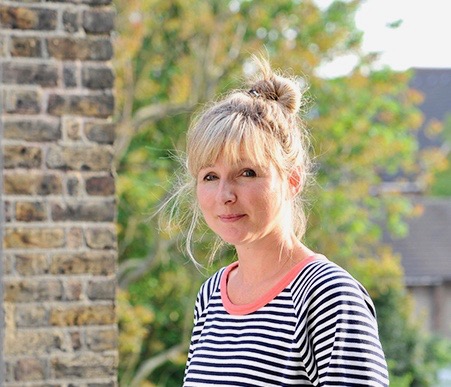Best low maintenance plants for pots – 7 varieties of fuss-free flowers and foliage that will survive without regular watering
There's no need to pamper these beauties-so you can relax this summer whether you're away or at home

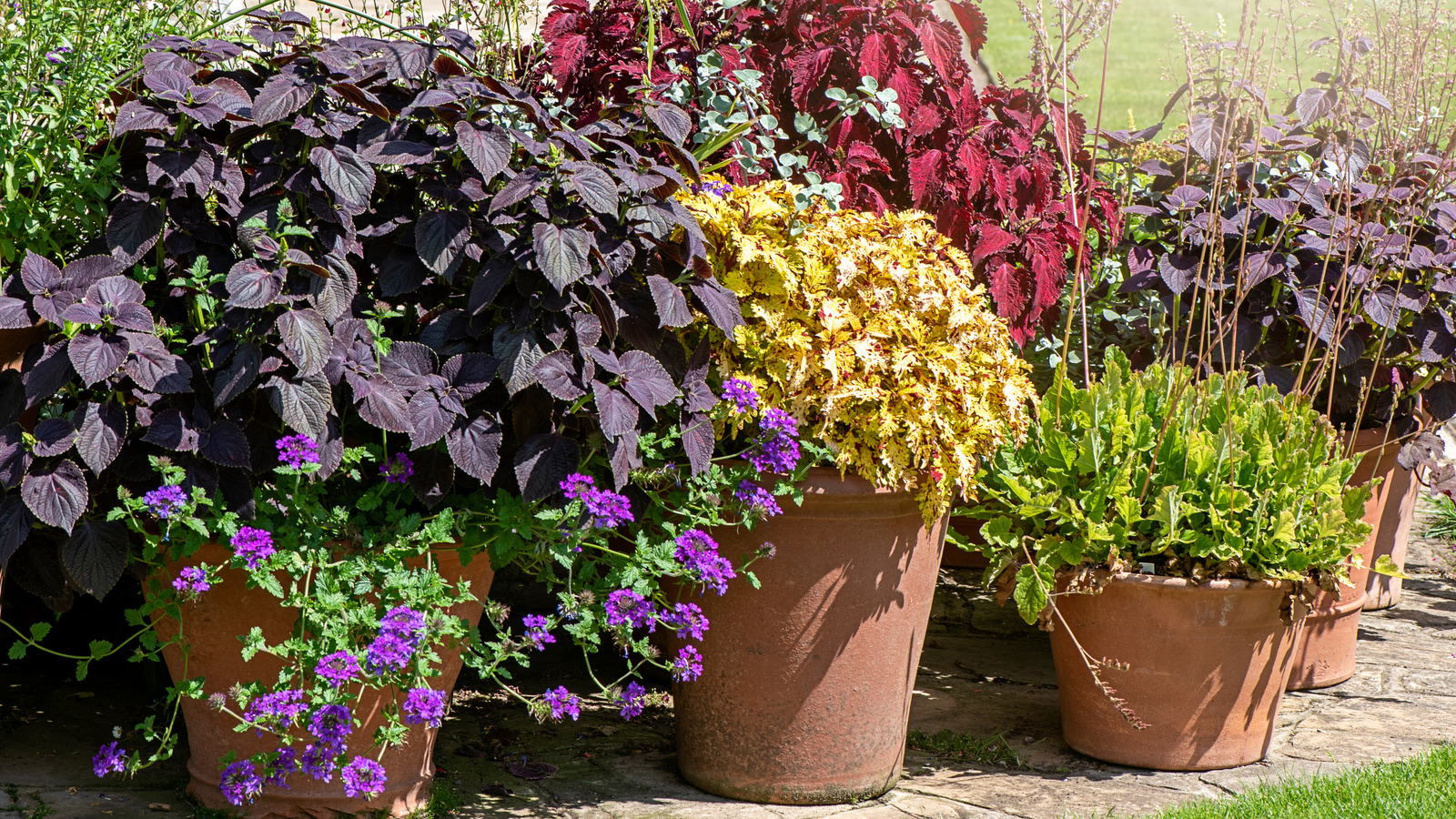
It's vacation time and while we all love to get away, it can bring up a little concern over our plants, and whether they will survive our absence. Yet that need not be the case with these low maintenance plants for pots.
If you've planned ahead, you may already have implemented some low maintenance backyard ideas. If not, it's not too late. Plants in flower beds tend to be more self-sufficient, while those in pots often require more frequent soaking during the warmer months.
However, there are several species that won't mind if you skip a few waterings or even disappear for a couple of weeks. These low maintenance plants for pots will thrive without constant care, so you can relax and enjoy the summer, whether you're at home or away.
7 low maintenance plants for pots
'As someone who fills my back deck with dozens of container ideas each year, I’ve learned the hard way which plants can handle a little neglect - especially when I’m off on summer adventures,' says Tabar Gifford, master gardener and representative, American Meadows.
'I’ve come to rely on a few go-to varieties that are not only beautiful and long-blooming but also incredibly low-maintenance. These plants don’t mind if I miss a watering (or three) and still reward me with months of color and pollinator activity.'
1. Coreopsis
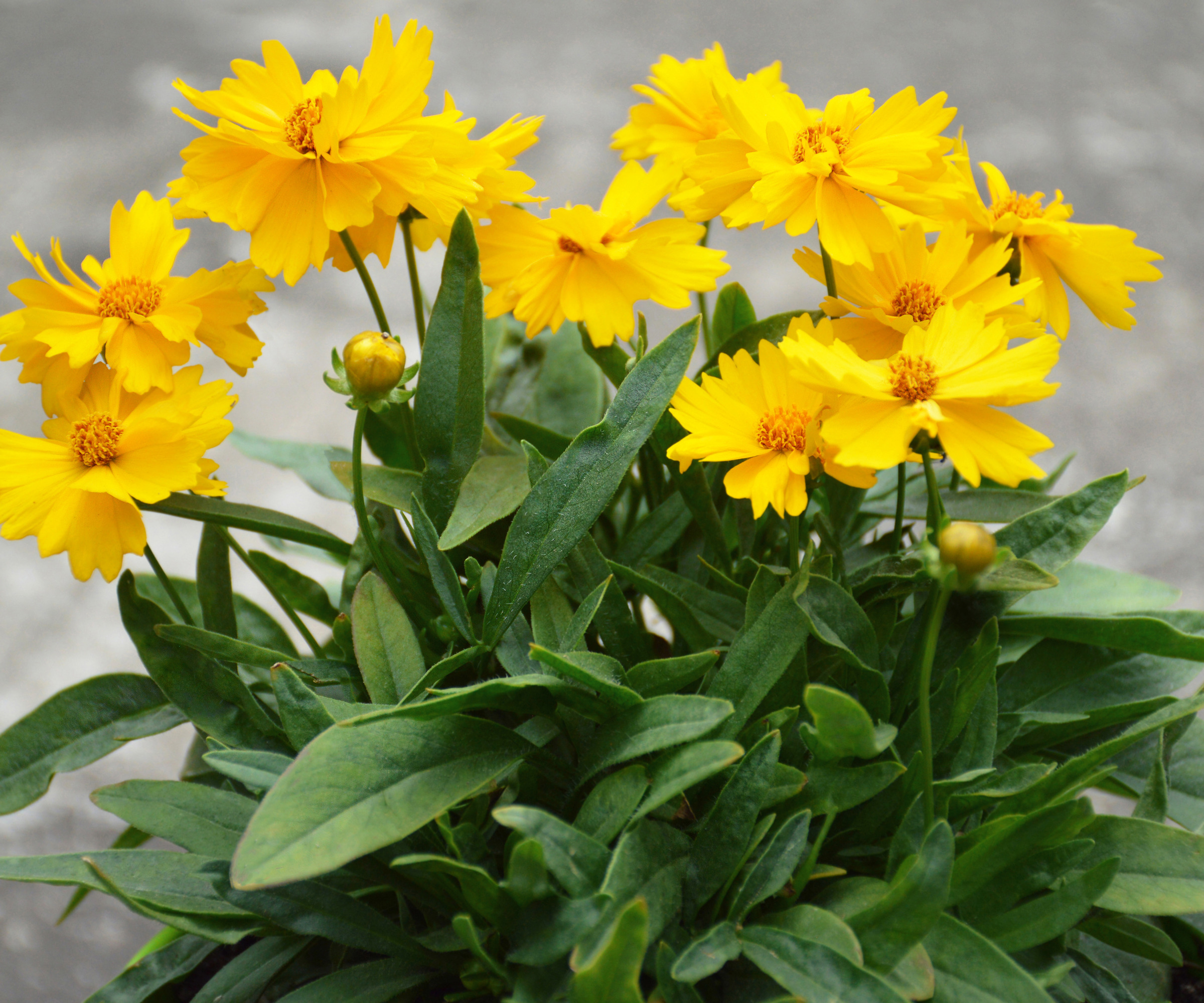
Also known as tickseed, Coreopisis is a summer favorite with many gardeners. As one of the longest flowering perennials, it's loved for its long bloom time. Its ruffled yellow flower heads appear in late spring and can keep blooming until late summer, so it's a cheerful addition for any container garden. It's also a plant that doesn't require much attention.
'Coreopsis is a rock-solid performer in pots - sun-loving, long-blooming, and incredibly resilient,' says Tabar Gifford. 'Most varieties are hardy in zones 4–9 and thrive in lean, well-drained soil. Their finely cut foliage stays neat, and the cheerful yellow or bi-color blooms keep coming with almost no effort.
Design expertise in your inbox – from inspiring decorating ideas and beautiful celebrity homes to practical gardening advice and shopping round-ups.
'Coreopsis grandiflora ‘Early Sunrise’ features semi-double golden blooms that look like little sunbursts. It grows to about 18 inches tall and has a slightly more upright habit, perfect for mid-layer planting. Like most coreopsis, it doesn’t mind poor soil and doesn’t need deadheading to keep flowering.
'A dense, compact cultivar with bright golden-yellow flowers is Coreopsis ‘Zagreb’. This forms tidy mounds around 12–15 inches tall. It’s super drought-tolerant and keeps blooming from early summer into fall. Its ferny foliage adds great texture to mixed containers.
'I love pairing Coreopsis with airy grasses or darker foliage—easy, elegant, and always moving in the breeze. They bloom for what feels like forever, which is an especially desirable quality when you’re someone who’s travelling a lot during bloom season.'
Plant these Coreopsis sunfire flower seeds from True Leaf Market now for cheerful summer blooms.
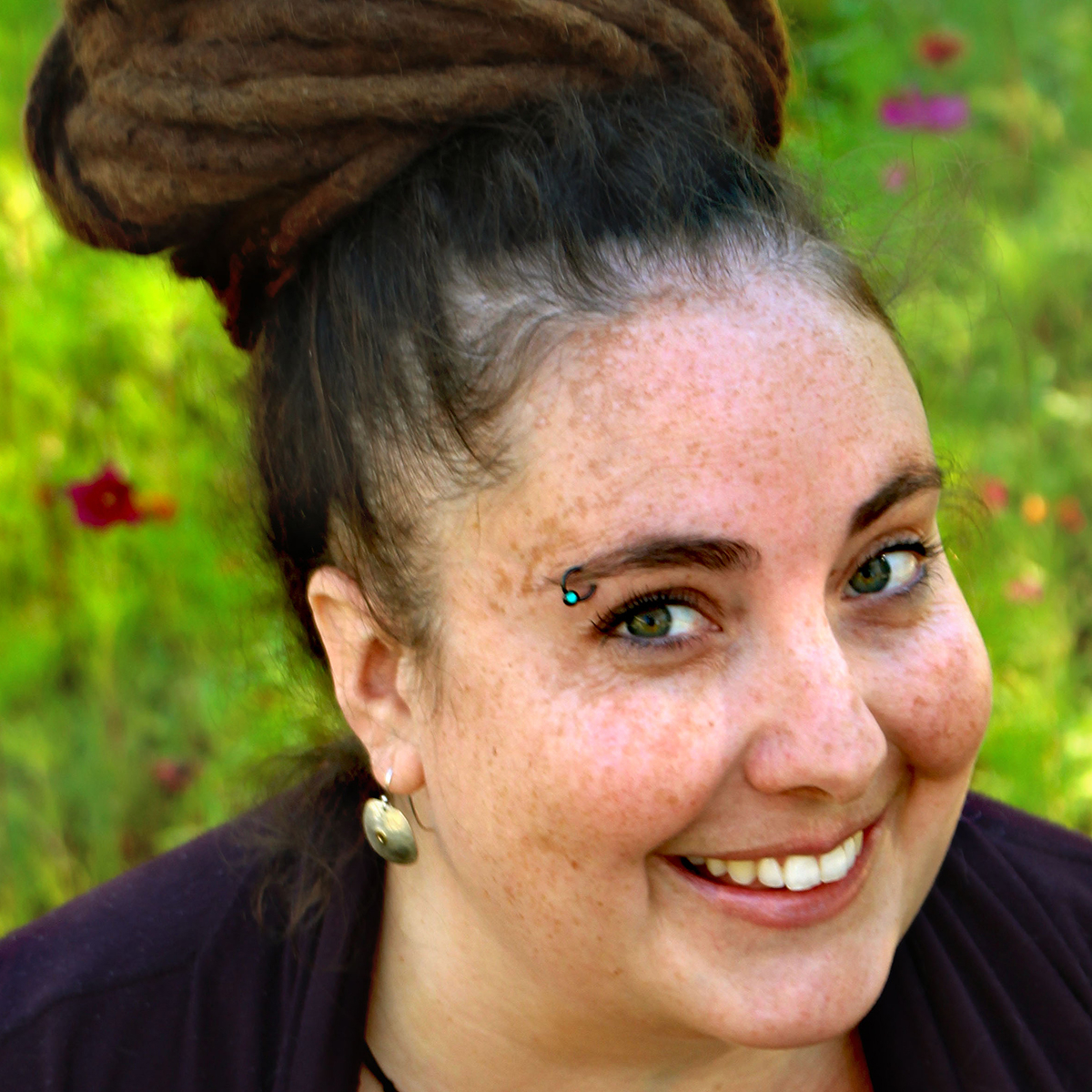
Tabar Gifford is a Master Gardener, and dedicated “plant geek”. With a lifelong love for gardening and nature, and a background in environmental studies and sustainable community development, she combines horticultural expertise with a commitment to education. Striving to empower individuals in achieving their gardening aspirations, Tabar embodies a genuine passion for sharing her knowledge. She gardens in zone 4 in Vermont.
2. Lavender (Lavendula spp.)
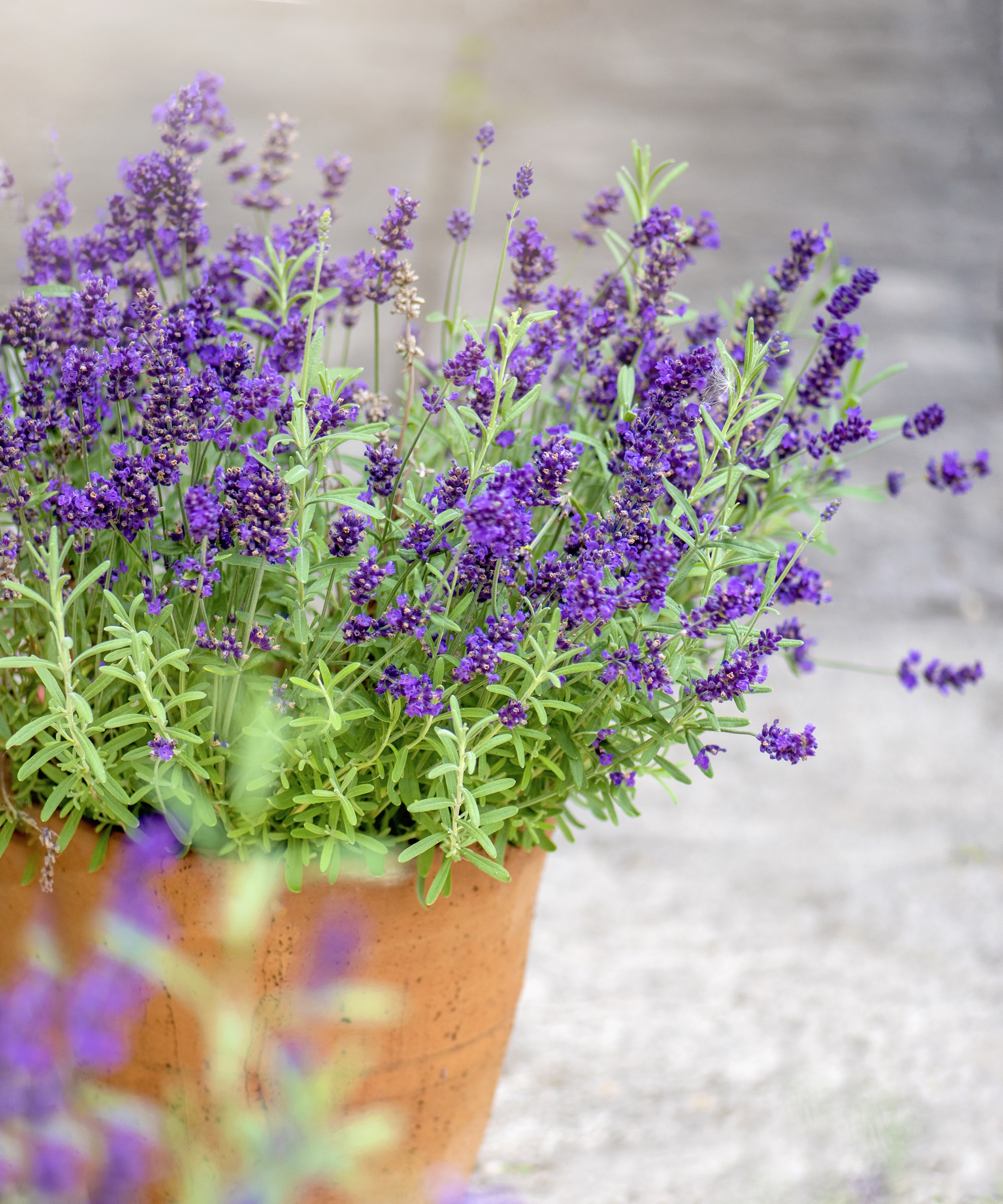
There's a reason lavender is a stalwart in many Mediterranean garden ideas, and it's not just due to its pretty color and calming perfume. This plant loves the sun and is seriously self-sufficient. It's a brilliant plant for pollinators, drought-tolerant and easy to grow.
'Lavender is the plant I use when I want my containers to look good and smell amazing with minimal work,' says Tabar. 'It thrives in full sun, lean soil, and dry conditions—basically, it prefers to be left alone. Perfect for zones 5–9, and container-friendly with good drainage.
'Lavender ‘Munstead is a classic English lavender with rich purple-blue flowers and compact size (around 12–18 inches tall). It's great for smaller pots, and one of the hardier lavenders out there. The fragrance is incredible, and it starts blooming in early summer.
'Another lovely variety is Lavender ‘Hidcote’, which has deep violet flowers on gray-green stems and a tighter, bushier habit than ‘Munstead’. It’s a top choice for edging pots or filling out mixed herb planters. It's also excellent for drying.
'A taller hybrid is Lavender ‘Phenomenal’ (up to 24–30 inches). It's more tolerant of heat and humidity, and still just as drought-hardy as the English types. It blooms profusely and holds its shape better in larger containers. Lavender pairs perfectly with other Mediterranean plants like rosemary, sedum, or even ornamental grasses. And bees? They love it.'
These heirloom Non-GMO Munstead Lavender seeds from True Leaf Market can be sown outside and will grow into robust fragrant plants.
3. Sedum
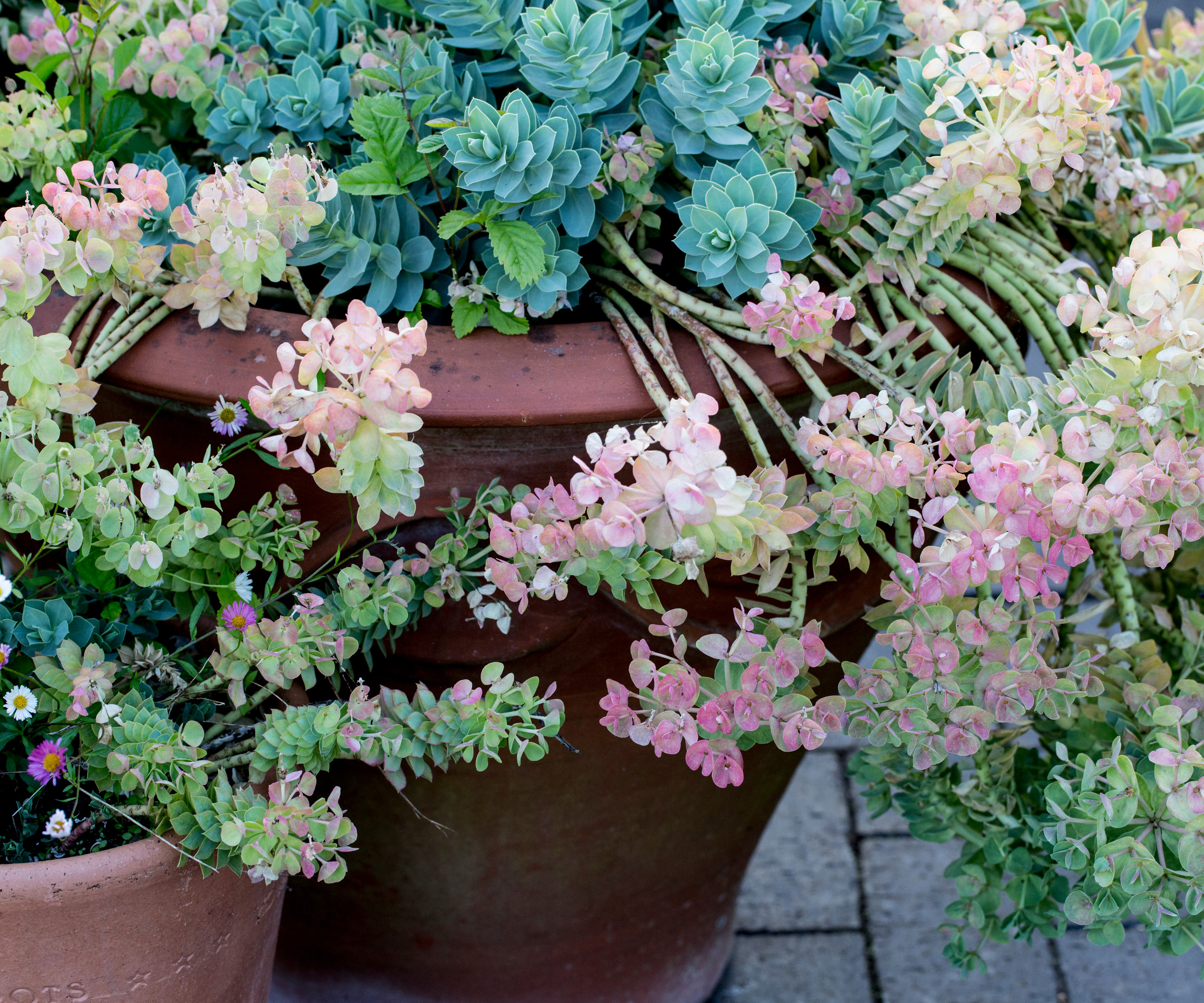
There's an enormous variety of sedum, and as succulents, these plants love the sun. This makes sedum wonderful low maintenance drought tolerant plants whether in pots, window boxes or baskets (and beds or borders). Due to the vast amount of choice, it's easy to find several sedum species to suit any style of drought-tolerant planting.
'If I had to name one plant family that’s made for low-maintenance containers, it would be sedums,' says Tabar. 'These succulents are unbeatable for tough conditions, and their diversity means you can use them as spillers, fillers, or focal points. Most are hardy in zones 3–9, need almost no water, and thrive in full sun.
'One favorite of mine is Sedum ‘Angelina', a low-growing, golden-green sedum which creates a soft, cascading carpet. It turns orange-red in cooler months for added fall interest. It’s a stunning spiller in pots, needs no pruning, and adds a bright contrast to darker-leaved plants.
'Another beautiful variety is Sedum ‘Dragon’s Blood’, a spreading groundcover with bold burgundy foliage and deep red flowers. It’s a great choice for dramatic edging in a mixed container or in its own shallow pot. It's hardy, colorful, and completely unfussy.
'A beloved upright sedum that grows about 18–24 inches tall is Sedum ‘Autumn Joy’. Its green, fleshy leaves support large, broccoli-like heads of pink flowers that age to copper through fall. These dried flower heads provide winter interest, too.
'Sedums are incredibly satisfying to grow - beautiful, architectural, and dependable. Just don’t overwater them, and they’ll take care of themselves.'
4. Million Bells Series (Calibrachoa)
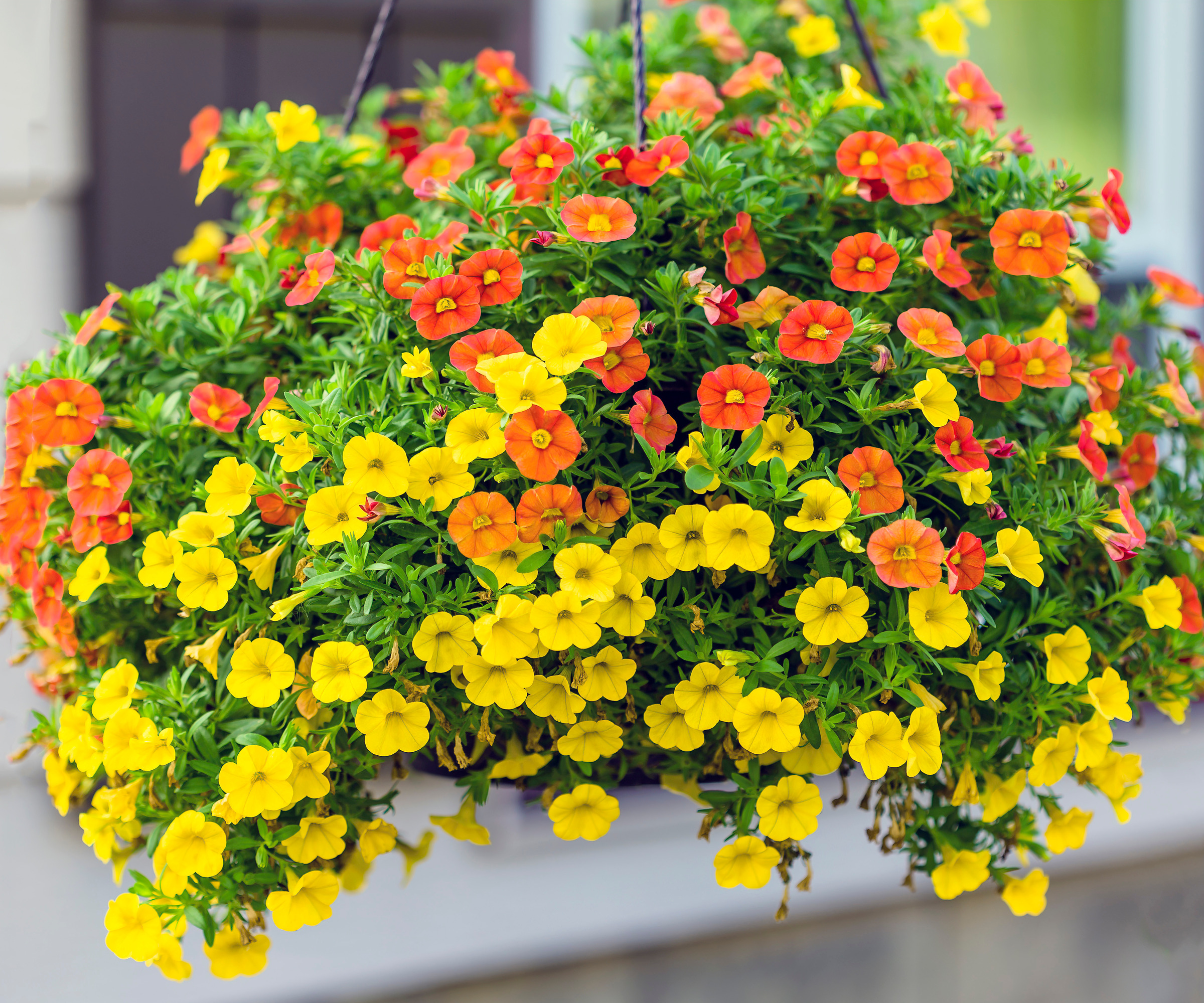
If it's an intense burst of color that you're after, look no further than Calibrachoa. These pretty sprawling plants are beautiful in pots, window boxes and hanging baskets. They suit a cottage garden style and are a good plant for pollinators, whilst also being deer resistant. They can cope without too much care too.
'Calibrachoa are tough little flowers with a delicate feel,' says Laura Janney, landscape architect and CEO, The Inspired Garden Masterclass. 'They come in so many gorgeous colors and patterns, making for some unique options for summer containers. We love using them as a spiller (or trailer) to create a touch of drama.
'They're a favorite for their ease of care, as they don’t require much deadheading or cutting back in order to continue blooming. In contrast, their larger cousins, the petunias, need a bit more maintenance as they become quite leggy and don’t do as well as in the heat of summer.
'These plants like full sun and well draining soil - and can handle a cold snap. In zones 9-11 they are grown as perennials. Otherwise they are annual in zones 1-8.'
The spectacular Calibrachoa Cherry Blossom from Burpee has a beautiful cherry pink and white bloom and is ready to plant from late April to mid-May.
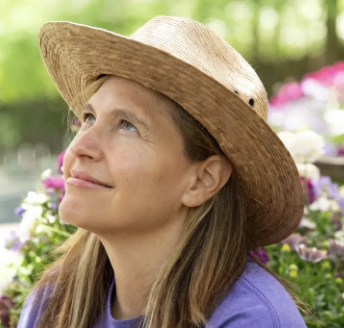
Laura Janney is a renowned landscape architect and designer, and CEO of The Inspired Garden Masterclass. Laura has left her mark on the cottage garden landscape design scene, recently winning the 2023 Houzz Best in Design award for her work in the New York area.
5. Periwinkle (Vinca)
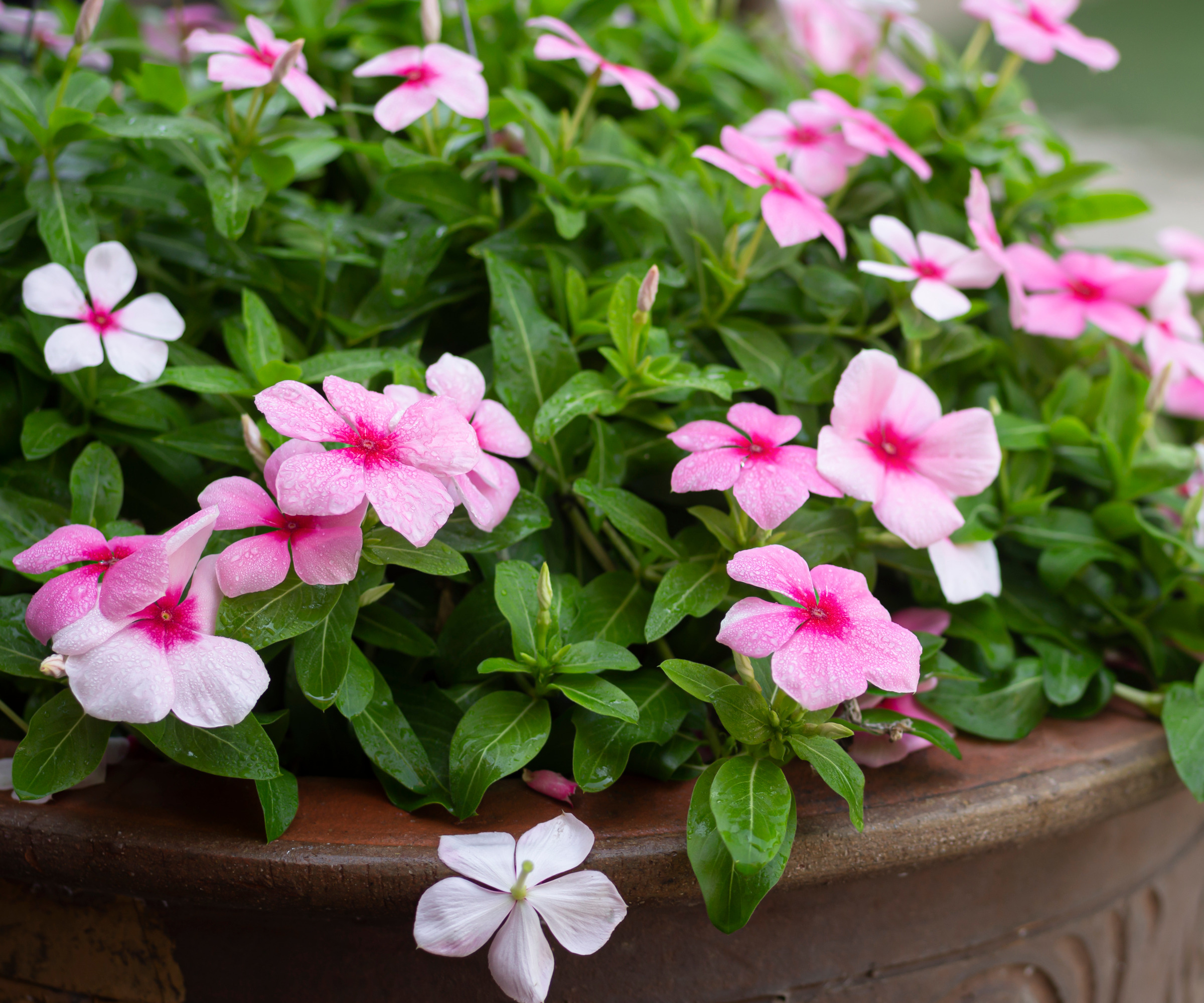
Another wonderful low-maintenance, deer resistant pollinator is periwinkle, also known as creeping myrtle. It flowers from spring to fall and is a good option for drought-resistant planting ideas. It is best watered in the mornings whenever it does need a drench, but does not like to be overwatered, so it can handle a run of hot dry days without attention.
'Vinca are extremely reliable; consistent bloomers and easy to pop in as a filler or can be used to fill an entire container,' says Laura. 'They are available in many color options, so it’s easy to find the hue that’s perfect for you.
'This plant does extremely well in the hot days of summer; it is heat tolerant and can handle periods of drought. Grow it in full sun in well draining soil. It's an annual in zones 1-9 and a perennial in 10-11.'
6. Palace Purple Coral Bells (Heuchera micrantha 'Palace Purple')
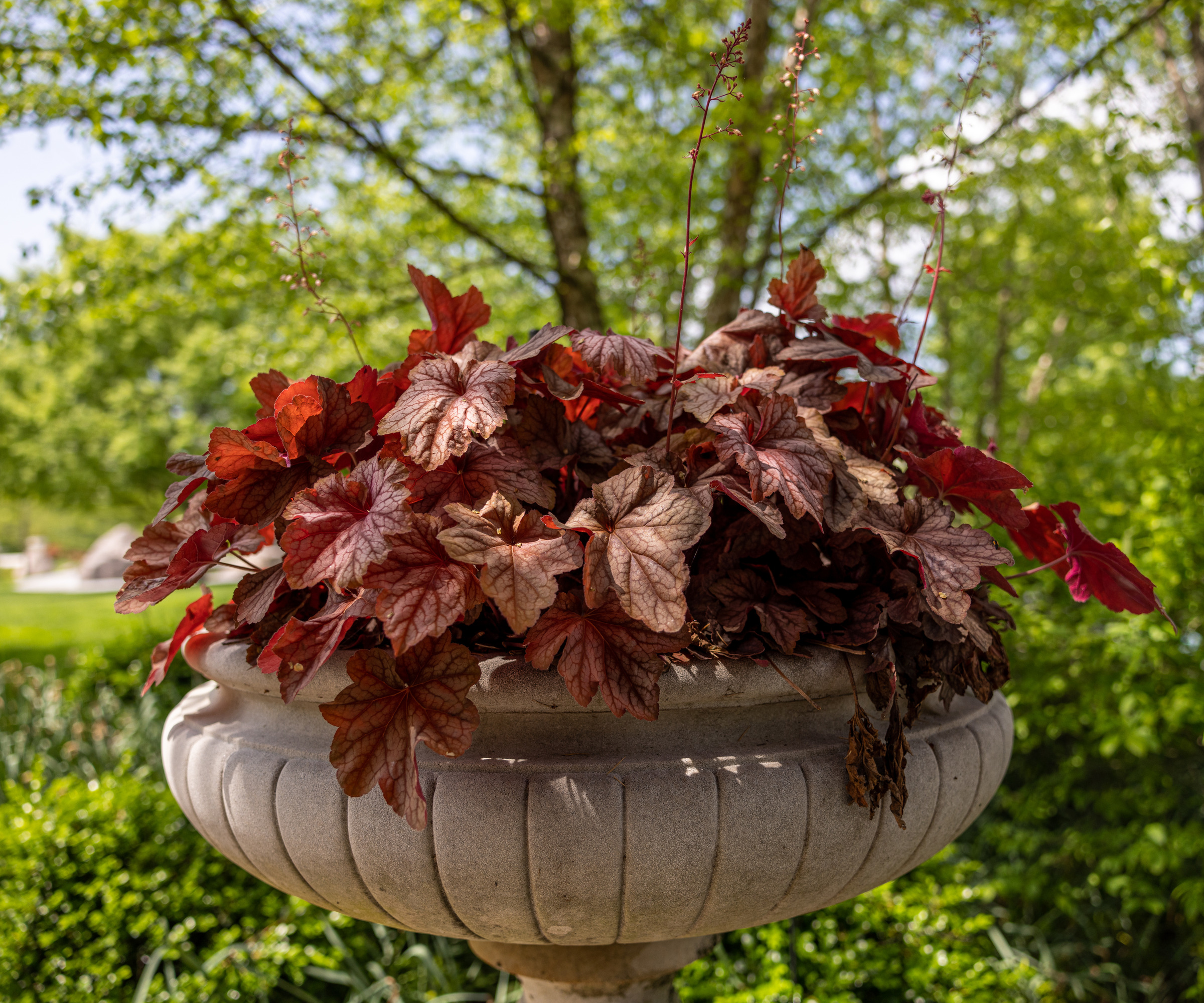
If you lean towards foliage over flowers but would like some color other than shades of green, the heuchera varieties are for you. Native to North American woodlands, these perennials have been hybridized and are available with an array of spectacular leaf hues, patterns and shapes.
'Palace Purple' Coral Bells is a popular variety that's easy to grow, with deep red foliage and pretty flowers too. It attracts hummingbirds, but is deer and rabbit resistance, so won't be chewed while you're away on vacation.
'A standby cultivar of heuchera with deep purple leaves, this is a winner for filling out a shady pot with durable long-lasting color, whether it's flowering or not,' says Megan Foster, perennial and bulb expert, American Meadows.
'For coral bells, be sure to include some nice organic material in the mix to help maintain even moisture on the hotter days and avoid full sun or afternoon sun in peak summer. This plant is well suited for zones 4-9 and pairs well with Carex.'

Megan is the category manager overseeing perennials and bulbs for American Meadows since 2019. With a keen eye for color and passion for pollinators she curates pre-planned gardens for the brand. Her instinct for what gardeners want also drives the spring and fall bulb assortments. She gardens in zone 5 in Vermont.
7. Carex (Cyperaceae)
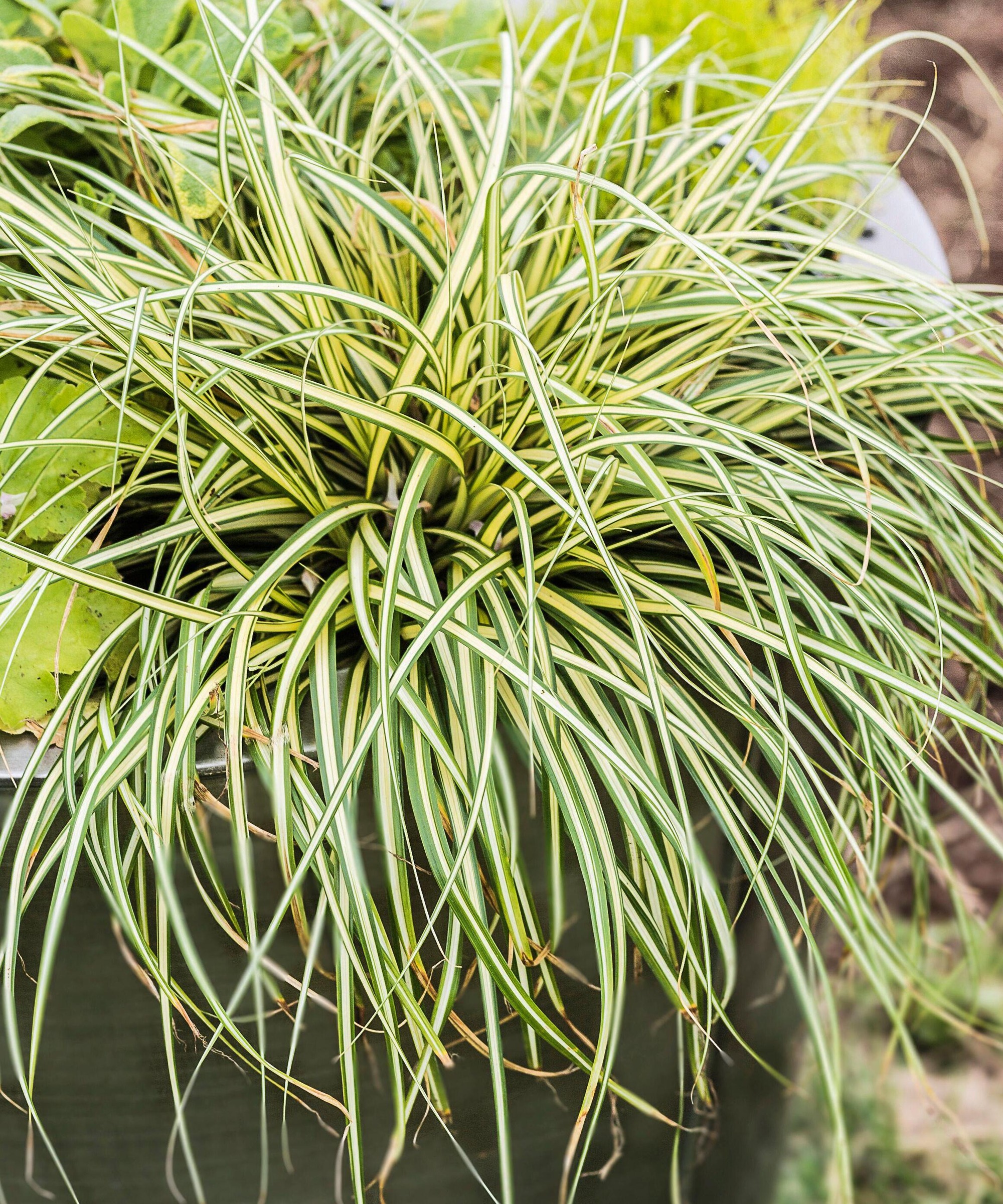
With their beautiful arching leaves, carex, (sometime called sedges) are a wonderful way to add elegance and greenery to your patio or porch. Many of these grass-like plants are evergreen, so look great all year round.
They are easy to grow and low maintenance, requiring barely any pruning. Most Carex varieties prefer a moist well-draining soil and light shade, so find a good spot and it will thrive, with little interference.
'Feather Falls sedge is a new Carex cultivar, and an excellent choice for pots, when you’re looking for that ‘spill’ factor,' says Megan.
'Its variegated cool green and white fine foliage is exceedingly long and swishy, creating a beautiful cascade over the edge of pots. It suits part shade, making it a really smart choice for recessed porches or entryways shaded by trees, and is well suited for zones 5-9.'
Whether you're drawn to a cottage garden style with colorful flowers or a more architectural aesthetic with interesting foliage on your patio, there are a plethora of low maintenance plants for pots. Whatever you choose to suit your space, you can do so with the knowledge that the plants selected here do not require constant care.
Jacky Parker is a freelance lifestyle journalist and writer, producing a wide range of features for magazines and websites. She has written for Homes & Gardens and its sister titles, Livingetc and Country Homes & Interiors for more than 15 years, both as a freelance contributor and staff member, regularly reporting on the latest interiors, gardens and lifestyle inspiration, speaking to experts in their respective fields and discovering the newest tips.
